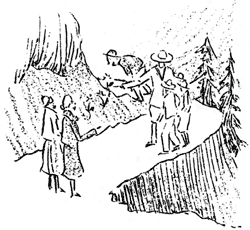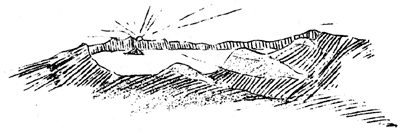|
DEPARTMENT OF INTERIOR
NATIONAL PARK SERVICE
CRATER LAKE NATIONAL PARK
OREGON
Mr. E. C. Solinsky
Superintendent |
Mr. D. S. Libbey
Park Naturalist |
|
September, 1932 |
Vol. V, No. 3 |
This publication is issued for the purpose of recording observations
and making known the results of research and scientific investigation
concerning the natural history of Crater Lake National Park. It is
under the jurisdiction of the Research and Education Staff and is
supplemental to the lectures and field excursions conducted by the
staff. Publications using these notes please give credit to the author
and to Crater Lake National Park Nature Notes.
The Community House
By D. S. Libbey
The cover design shows the Community House at Crater Lake National
Park. Many of you will recall the programs of song, music, informative
talks and moving pictures. Our hosts, Rangers Ray Henderson and George
F. Barron, are to be congratulated upon the very commendable character
of the programs. This season the Community House programs began July
12. The excessive snow in the campgrounds prevented overnight campers
until approximately that date and the last program of the current season
was held on the night of September 16.

The purpose of the nightly programs is to enable each visitor to
learn of the many features of the park. Below appears a copy of a
letter written by a visitor of the past season concerning his stay at
Crater Lake.
"My wife and I, with our boys, have visited thirteen of your
national parks, several national monuments, and many state parks, --
always with the idea of delving into their concealed recesses as well as
obvious points of interest, to enjoy them to the utmost.
"So we strolled with Ranger Naturalist Constance up Garfield Peak
and learned the names of your plants and flowers, and got a bird's eye
view of the terrain we planned to explore.
"We went several times to Sinnott Memorial to hear the story of the
building up of the mountain, its destruction and the creation of
beautiful Crater Lake from Mr. Count and Mr. Clark, -- always
fascinating and never in the same language, but always consistent,
without poll-parrot repetition.
"We visited the Pinnacles on Wheeler Creek, recalling Bryce Canyon,
yet distinctive. Saw the declining rays on the Sun Notch when Kerr was
in shadow.


"That same day we travelled around the Rim Road to the north side of
the lake and then around to Red Cone -- deer tracks across the snow in
its crater. Rim Road was not yet cleared of snow, so returned
clockwise, with gorgeous sunset views from Wineglass and Cloud Cap. Met
up with a porcupine on Vidae Ridge in the dunkelheit, side-swiped him
with a sweater and collected some souvenir quills. But that evening we
got to Rim Camp at 8:30, -- the hot showers were so rejuvenating, but
missed the Community House gathering for the Sagebrushers. Otherwise we
had the pleasure of Ranger Henderson's programs for six evenings. He is
doing a splendid piece of work.
|
"It took us two hours to scramble up to the top of Mt. Scott and
after asking endless questions of Lookout Doc Grimm for an hour
concerning the Klamath County and the Pumice Desert, came down the
pumice slide in four minutes.

|

|
"We climbed the trail to the Watchman Viewpoint and looked down on
Wizard Island, oriented our topographic map on Mt. Hillman. Ranger
Henderson said the color of the lake could not be fully appreciated from
the Rim, although we did get up at 4:30 A.M., to see the sunrise effects
-- so we rowed all around Wizard Island, climbed up to its top on the
spiral trail and "nature toboganned" down into the pit of the crater on
the snow banks. The journey back was dusty and warm so we stript to
"Shorts" and dove off the dock on the Wizard Island shore. We keenly
felt that 39 degrees was the correct temperature of Crater Lake. By
that time we had been above it, around it, on it, and under it!

|
"On the way, leaving the park, we crawled through the ice caves of
Llao's Hallway, and got samples of rocks that float. Swam in the
Rogue River at Natural Bridge.
"A deep impression will last of the splendid manner in which members
of the Naturalist Staff aroused such understanding interest in the minds
of the group at the Community House gatherings. Without scorn for our
lack of knowledge concerning intricate scientific problems and without
speaking in a condescending manner the lectures were delivered.
"Such is the way myself and family came to know and appreciate
Crater Lake. We enjoyed our stay on the Rim; we must come back in the
future to love it all again."
Yours sincerely,
(Sgd.) A 1932 VISITOR
Cave
By Park Naturalist D. S. Libbey

The rediscovery of a cavern in the area of Crater Lake National Park
is of considerable interest. It is located along the north exposure of
the cliff midway between Mt. Scott and the lake, about three-fourths of
a mile away from the Rim. The grotto is not one formed by the flowing
of lava through a passage way, a lava tunnel, but is a cavity caused by
the solution activity of ground water.
The cavern is about 200 feet long and extends backward into the
cliff of andesite rock. The mouth is about 50 feet wide and from 7 to 8
feet high. The walls are covered in many places by stalactitic
deposits. Curiously these cave deposits are not calcareous but are
siliceous. It appears that the weathering action has caused the
plagioclase feldspar to be decomposed and the resulting solution
activity has caused the silica to be taken into solution and then to be
deposited when exposed to the air. Many surfaces are covered with
siliceous dripstone formations.
This cave was discovered during the current season by a group of
workmen engaged in the Pine Beetle Control work. There is a story
attached to this cave.
The story says that an Indian named Pedro years ago visited
Linkville, now called Klamath Falls, and told of a very rich gold
deposit he had discovered. Two Indians in the vicinity of Linkville
followed Pedro back to the region and there found that in place of
having discovered a gold deposit that Pedro had found two prospectors
carrying very valuable sacks of gold. He murdered the prospectors and
cached the stolen plunder in the cave. So goes the story, the
authenticity of this seems to be varified by the fact that our park
workmen found the cave in exactly the location described by an old
Indian this current summer.
| 
